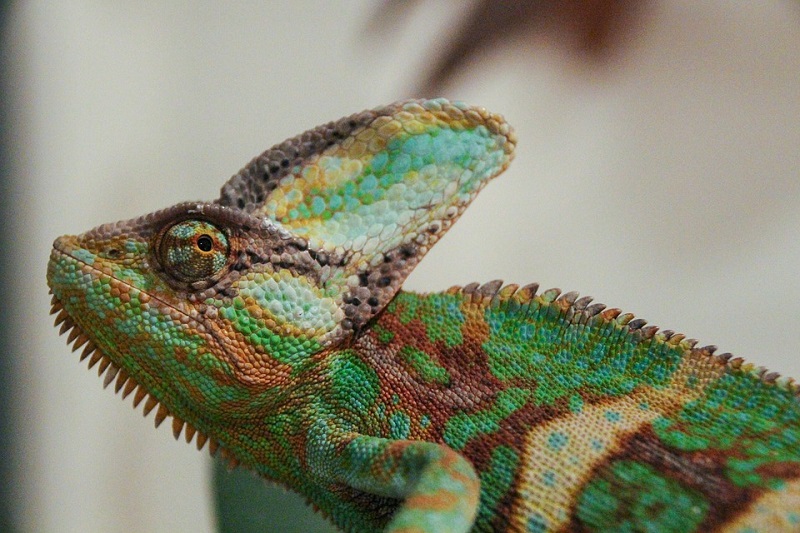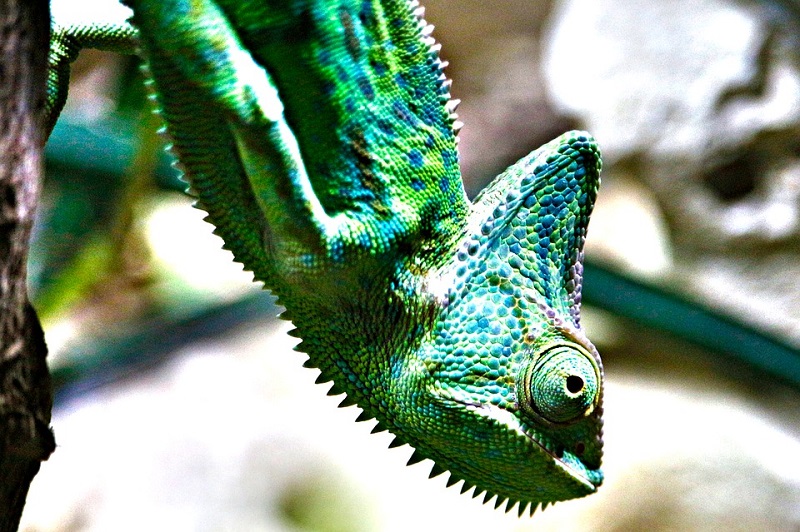 |
| ▲ Chameleon has a different character for each breed (Source: Pixar Bay) |
Chameleon is a colorful lizard that can turn itself into various colors. Chameleon uses this ability as a means of camouflage or communication. There are 202 species of chameleon distributed worldwide, each with its own shape, size and color. And they have characteristics that are as different as their appearance.
Cage
Chameleon is one of the animals that is difficult to control due to its inherent habit. Because chameleon is a water animal that lives only on trees, the cage must have many twigs and leaves that can ride on this creature. Sufficient space must be ensured for the chameleon to exercise. It should also be made of materials that are easy to clean.
It should also be ventilated and a poly mesh or vinyl coated wire mesh is recommended on three sides to prevent toe injury. Floors made of small particles such as gravel, sand, bark, and moss should be avoided. Chameleon can catch food and accidentally eat it. And you have to make a sunbathing space with different temperatures. Because the recommended temperature differs for each breed, you should be familiar with the information about your breed.
Chameleon ingests moisture with water droplets on the leaves placed in the cage. Therefore, it is necessary to install a drip system or a spray device in the cage. When using a drip system, water should be allowed to come out at regular intervals to allow the chameleon to find water. Sprayers also help maintain moisture levels.
light
If you are the first to bring a chameleon, you should know that the chameleon is absolutely dependent on the special wavelength of the bulb. Chameleon requires UVA and UVB exposure. Among them, 12 hours of daily UV-B exposure is required. This can be achieved with natural light coming in without special bulbs or filters. If chameleons are grown indoors only, a light bulb with a UVB of 5% or more should be used. If this condition is not met, the chameleon will not be able to use calcium properly, regardless of what food it feeds on. Therefore, the UVB lamp should be left on for 10 to 12 hours every day. However, care should be taken to prevent the chameleon from getting burned by the light bulb.
 |
| ▲ Chameleon needs UVA and UVB lighting (Source: Pixar Bay) |
Food and drinking water
Chameleon is a carnivore. That means eating insects and other small animals. Wild chameleons can eat a variety of insects, but usually eat crickets when raised. Green leafy vegetables, oats, broccoli and many other fruits. Feeding insects are also recommended to feed as many as possible, such as crickets, wheat worms, and cockroaches. It is good to sprinkle calcium supplements and vitamin D on the food.
General health problems
Chameleon can be sick for a variety of reasons. It is predominantly vulnerable to bacteria, fungi, and viral infections, and parasites of various kinds can be parasitic. Therefore, to maintain the health of chameleons, clean the cage daily and avoid contact with other chameleons. If you already have reptiles in your home, the newly adopted chameleon should be isolated for a minimum of 1 to 3 months to prevent transmission of the disease. Many chameleons are suffering from calcium and vitamin A deficiency because they can not eat properly.
It also suffers from stomatitis with infection symptoms around the mouth. Other common diseases that chameleon has are metabolic bone disease. A disease that can be fatal if not treated properly is a bone sponge-like symptom. And it looks helpless and loses appetite. If the pet chameleon appears sick or stressed, you should immediately seek a reptile veterinarian.
Chameleons can be charming pets like other reptiles, but you have to learn how to manage them properly. Chameleons can be safely kept very submissive if properly managed.
![[Pet] Everything about chameleon ‘From cage selection to health care’ pet everything about chameleon from cage selection to health care](https://moontore.com/wp-content/uploads/2019/02/pet-everything-about-chameleon-from-cage-selection-to-health-care-1200x700.jpg)


